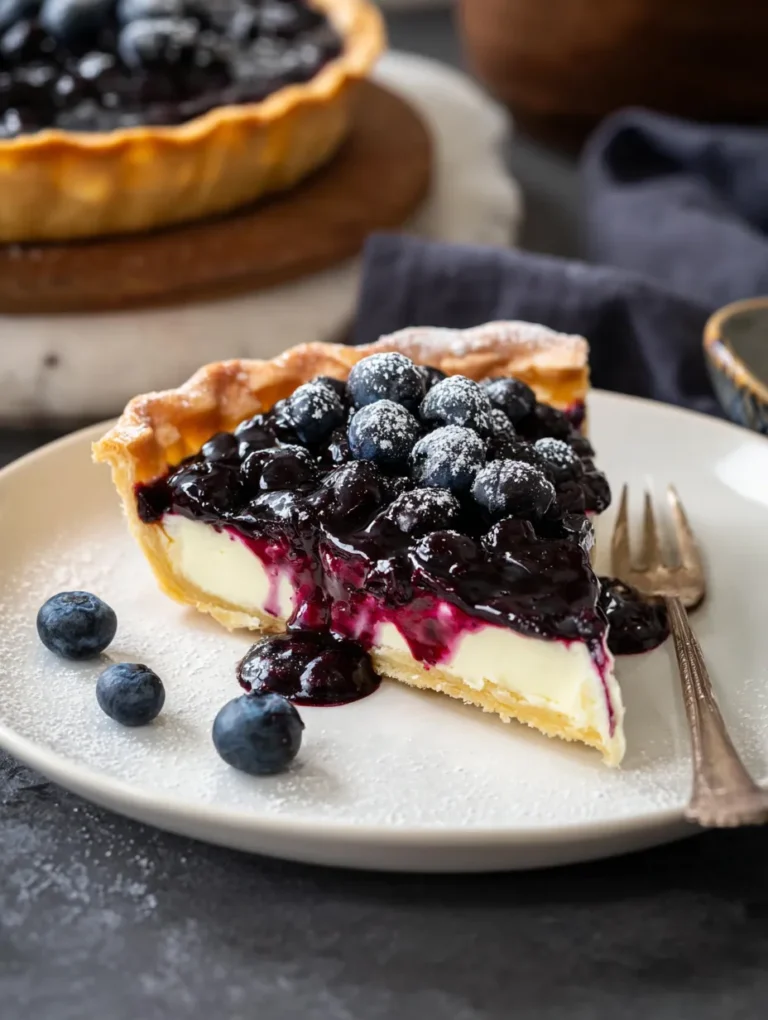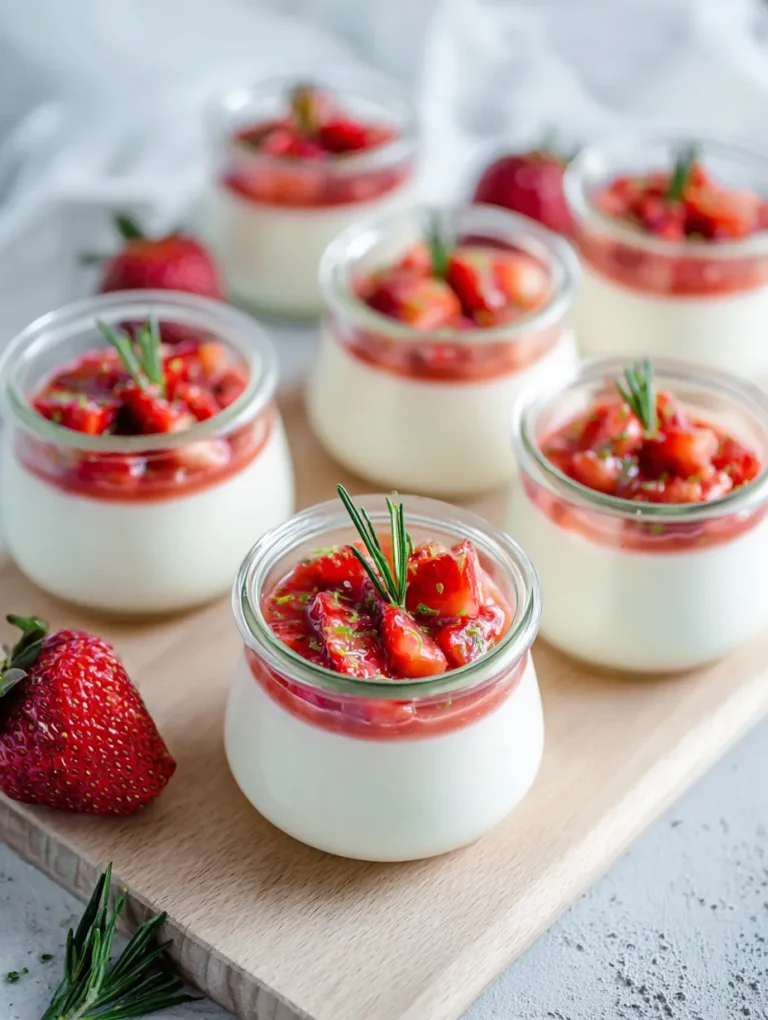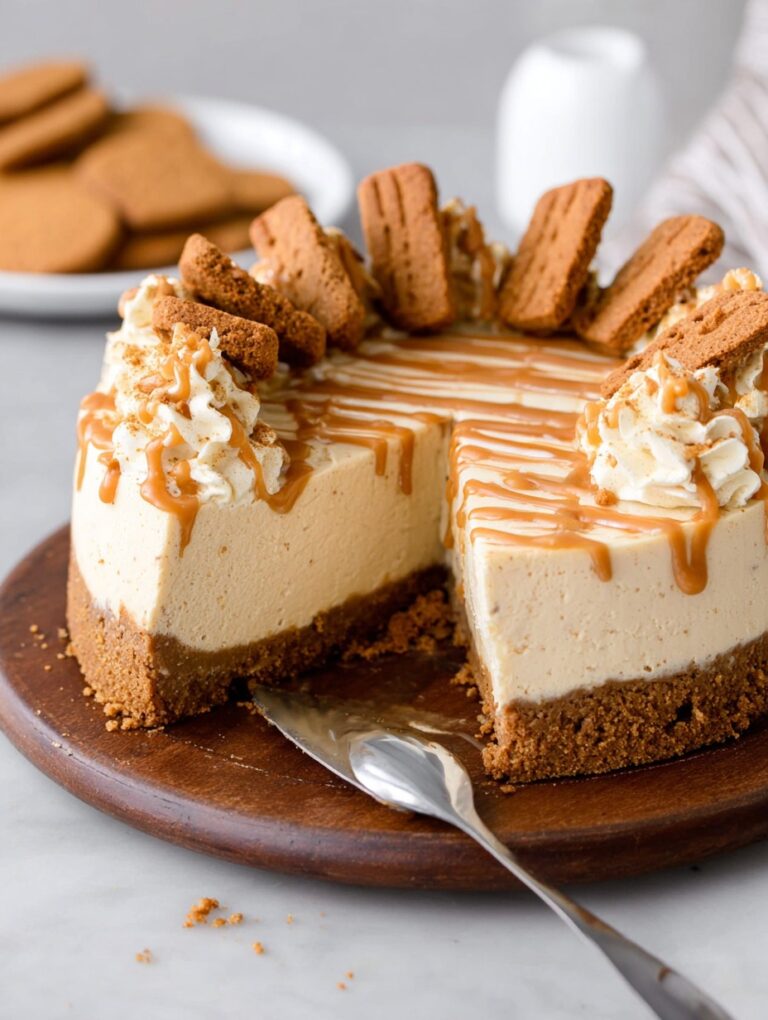The Ultimate German Chocolate Cake Recipe (With Coconut Pecan Frosting!)
Discover the secrets to making authentic German chocolate cake with its signature coconut pecan frosting. This homemade recipe creates three decadent layers of moist chocolate cake topped with the classic caramel-like frosting that made this dessert famous since 1957.
⭐⭐⭐⭐⭐ 4.5 from 245 reviews | 📌 Save Recipe | 🖨️ Print | 💬 387 Comments
The Fascinating Story Behind German Chocolate Cake
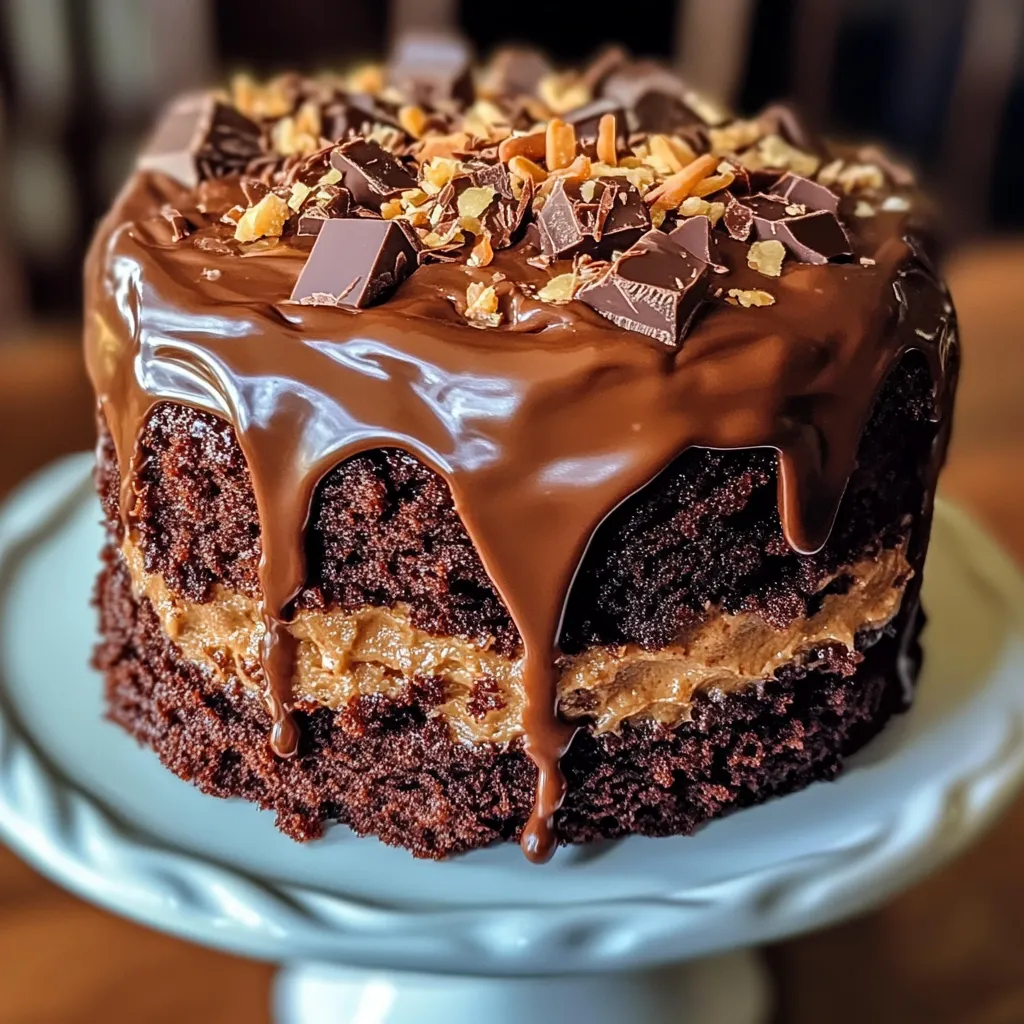
Before we dive into this incredible German chocolate cake recipe, let’s clear up the biggest misconception: this cake isn’t German at all! The German chocolate cake origin story begins in 1852 when Sam German, an American baker, created a special dark baking chocolate for Baker’s Chocolate Company. Over a century later, in 1957, a Dallas homemaker named Mrs. George Clay submitted a recipe using “German’s Sweet Chocolate” to a local newspaper.
The original German chocolate cake recipe from 1957 became so popular that General Foods (which owned Baker’s Chocolate) distributed it nationwide, and somewhere along the way, the possessive “German’s” became simply “German,” leading millions to believe this was a traditional German dessert. This fascinating German chocolate cake history makes it a uniquely American creation that has become one of our most beloved celebration cakes.
What Is German Chocolate Cake?
German chocolate cake is a three-layer chocolate cake made with sweet baking chocolate, filled and topped with a distinctive coconut pecan frosting rather than traditional chocolate frosting. Unlike regular chocolate cakes that use cocoa powder, authentic German chocolate cake uses melted German’s sweet chocolate, creating a milder, sweeter chocolate flavor that perfectly complements the rich coconut pecan topping.

What makes German chocolate cake unique:
- Sweet chocolate base (not dark or semi-sweet)
- Buttermilk for tenderness and slight tang
- Whipped egg whites for incredible lightness
- Coconut pecan frosting instead of buttercream
- Exposed sides showing off the beautiful layers
- Caramel-like frosting that’s cooked on the stovetop
Essential Ingredients for German Chocolate Cake
For the Chocolate Cake Layers:
- 1 (4oz) package German’s Sweet Chocolate – Baker’s brand is traditional
- 1/2 cup (4oz) boiling water – to melt the chocolate
- 2 sticks (226g) unsalted butter, room temperature
- 2 cups (400g) granulated sugar
- 4 large egg yolks, separated (save the whites!)
- 1 teaspoon pure vanilla extract
- 2 cups (240g) all-purpose flour, sifted
- 1 teaspoon baking soda
- 1/2 teaspoon salt
- 1 cup (8oz) buttermilk, room temperature
- 4 large egg whites – for folding in
For the Coconut Pecan Frosting:
- 1 (12oz) can evaporated milk – not condensed!
- 1 1/2 cups (300g) granulated sugar
- 1 1/2 sticks (170g) unsalted butter
- 4 large egg yolks, lightly beaten
- 1 1/2 teaspoons vanilla extract
- 1 (7oz) package sweetened flaked coconut – Baker’s Angel Flake
- 1/2 cup (65g) chopped pecans, toasted for extra flavor
Ingredient Notes & Substitutions:
German Chocolate: If you can’t find Baker’s German Sweet Chocolate, substitute with 3 oz semi-sweet chocolate plus 1 tablespoon sugar. The flavor won’t be identical but will work.
Buttermilk Substitute: Mix 1 cup whole milk with 1 tablespoon lemon juice or white vinegar. Let stand 5 minutes before using.
Pecans: Can substitute with walnuts or omit for nut-free version. Toasting enhances flavor significantly.
Coconut: Sweetened flaked coconut is traditional, but unsweetened works with added sugar adjustment.
How to Make German Chocolate Cake (Step-by-Step)
Preparing Your Workspace
Step 1: Set Up for Success Preheat your oven to 350°F (175°C). Position the rack in the center for even baking. Prepare two 8″ x 3″ round cake pans (or three 9″ pans for thinner layers) by:
- Buttering the sides thoroughly
- Lining bottoms with parchment paper circles
- Dusting with cocoa powder (not flour – keeps it chocolate!)
- Tapping out excess
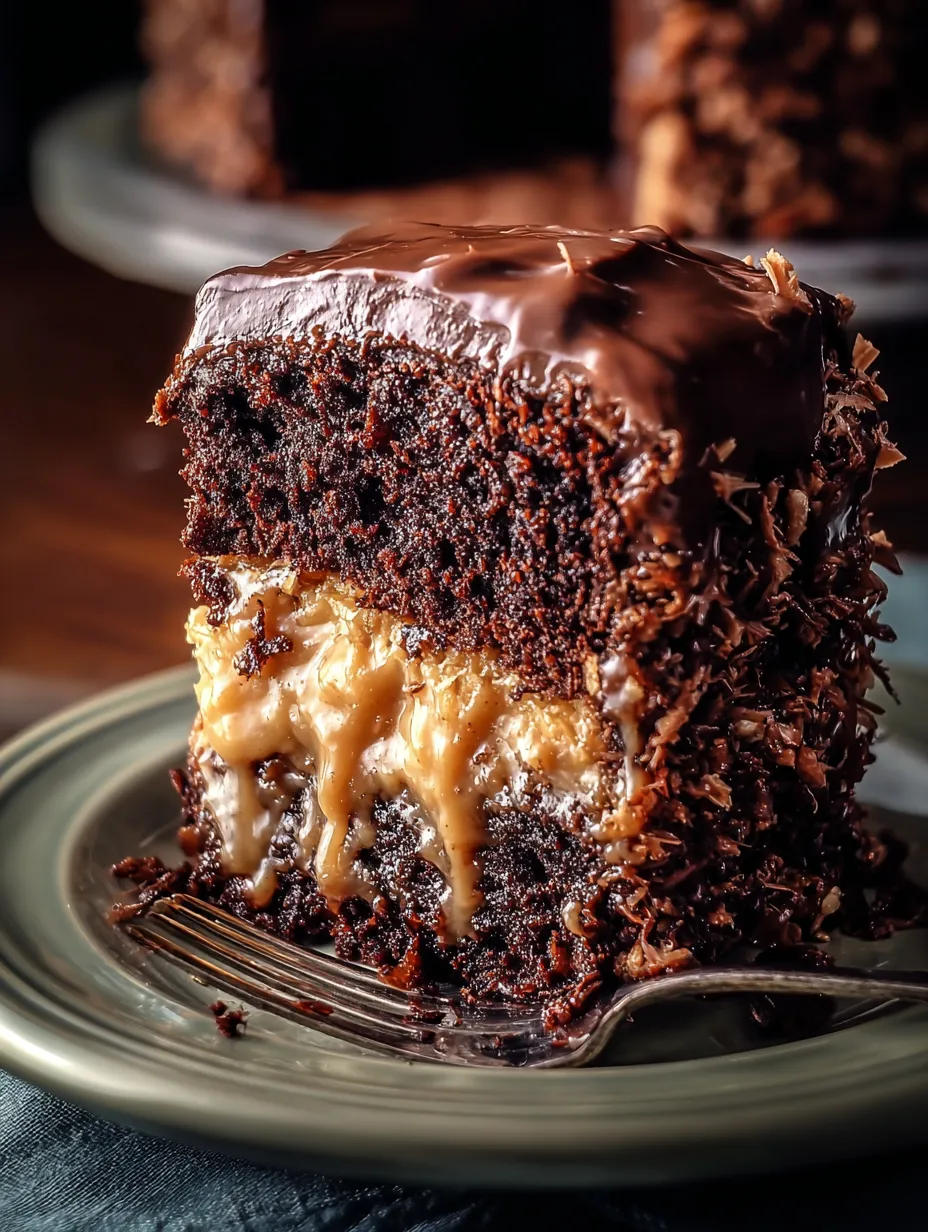
The Ultimate German Chocolate Cake Recipe (With Coconut Pecan Frosting!
Ingredients
Equipment
Method
- Preheat oven to 350°F (175°C). Grease and line pans with parchment, dust with cocoa powder.
- Melt German chocolate in boiling water, stir smooth, cool.
- Cream butter and sugar until pale and fluffy, 3 minutes.
- Beat in egg yolks one at a time until ribbony. Mix in cooled chocolate and vanilla.
- Sift flour, baking soda, and salt. Alternate adding dry mixture with buttermilk, starting and ending with flour.
- Beat egg whites to stiff peaks. Fold gently into batter in three additions.
- Divide into pans, smooth tops, bake 30–35 minutes until toothpick shows moist crumbs.
- Cool 10 minutes in pans, invert onto racks, cool fully 2 hours.
- Make frosting: Combine evaporated milk, sugar, butter, yolks, and vanilla in saucepan. Cook over medium, stirring constantly 12 minutes until thickened.
- Remove from heat, stir in coconut and toasted pecans. Cool until spreadable.
- Assemble: Level layers. Spread frosting between layers and on top. Leave sides bare.
Notes
- Substitute German’s chocolate with 3 oz semi-sweet + 1 tbsp sugar if unavailable.
- Buttermilk substitute: 1 cup milk + 1 tbsp vinegar/lemon juice, rest 5 min.
Nut-free: Omit pecans or replace with walnuts. - Vegan: Use flax eggs, vegan butter, coconut milk, aquafaba for whites.
- Gluten-free: Replace flour with 1:1 gluten-free blend + xanthan gum.
- Variations: Cupcakes (18–20 min bake), Bundt cake, Poke cake, Cookies.
- Storage: Room temp 2 days, fridge 5 days, freezer 3 months.
Pro Tip: Deep pans (3″ sides) prevent overflow as this batter rises significantly. If using standard 2″ pans, use three instead of two.
Making the Chocolate Cake Batter
Step 2: Melt the Chocolate Break the German chocolate into pieces and place in a heatproof bowl. Pour the 1/2 cup boiling water over it and stir until completely melted and smooth. Set aside to cool to room temperature – hot chocolate will cook the eggs!
Step 3: Cream Butter and Sugar (Critical Step!) In your stand mixer with paddle attachment, cream the room temperature butter and sugar on medium-high speed for exactly 3 minutes. The mixture should be pale, fluffy, and increased in volume. Scrape the bowl halfway through – sugar likes to hide at the bottom.
Why This Matters: Proper creaming creates air pockets that give the cake its light texture. Under-creaming = dense cake.
Step 4: Add Egg Yolks Gradually Add egg yolks one at a time, beating well after each addition. Mix on medium-high for 4 minutes total until the mixture is pale yellow and ribbony. This creates the emulsion that holds everything together.
Step 5: Incorporate Chocolate and Vanilla With mixer on low, add the cooled melted chocolate and vanilla. Mix on medium speed for 3 minutes until fully combined. The batter will look rich and glossy.
Step 6: Alternate Dry and Wet Ingredients
- Sift together flour, baking soda, and salt in a bowl
- With mixer on low, add flour mixture in three additions
- Alternate with buttermilk in two additions
- Start and end with flour (flour-milk-flour-milk-flour)
- Mix just until combined after each addition
The Science: Alternating prevents the batter from curdling and ensures even distribution without overmixing.
Step 7: Whip and Fold Egg Whites In a clean bowl with whisk attachment, beat egg whites on high speed for 5 minutes until stiff peaks form. They should stand straight up when you lift the beaters.
Using a large rubber spatula, fold 1/3 of the whites into the chocolate batter to lighten it. Then gently fold in remaining whites in two additions. Use a cutting and folding motion – don’t stir!
This Is The Secret: Whipped egg whites make German chocolate cake incredibly light and tender, unlike dense regular chocolate cakes.
Step 8: Bake to Perfection
- Divide batter evenly between prepared pans (use a scale for accuracy)
- Smooth tops gently with offset spatula
- Bake for 30-35 minutes (test at 30)
- Cakes are done when:
- Toothpick inserted in center comes out with just a few moist crumbs
- Sides pull slightly from pan
- Top springs back when lightly touched
Step 9: Cool Properly
- Cool in pans on wire racks for exactly 10 minutes
- Run knife around edges to loosen
- Invert onto racks, remove parchment
- Cool completely before frosting (about 2 hours)
Making the Signature Coconut Pecan Frosting
Step 10: Prepare the Frosting Base In a large saucepan, combine evaporated milk, sugar, butter, beaten egg yolks, and vanilla. Don’t worry about the raw eggs – they’ll cook thoroughly.
Step 11: Cook to Perfection Cook over medium heat, stirring constantly with a wooden spoon for exactly 12 minutes. The mixture will:
- Start thin and yellow
- Gradually thicken
- Bubble gently (never boil vigorously)
- Coat the back of a spoon when ready
- Reach 170°F if using a thermometer
Critical: Never stop stirring or eggs will scramble. If lumps form, strain through fine mesh sieve.
Step 12: Add Coconut and Pecans Remove from heat and immediately stir in coconut and toasted pecans. The hot mixture will slightly toast the coconut, enhancing flavor. Mix thoroughly until evenly distributed.
Step 13: Cool Completely Transfer to a bowl and press plastic wrap directly on surface to prevent skin forming. Cool to room temperature, then refrigerate until thick and spreadable, about 2 hours. The frosting will thicken significantly as it cools.
Assembling Your German Chocolate Cake
Step 14: Level the Layers Using a long serrated knife, level cake tops if domed. Save scraps for snacking!
Step 15: Apply First Layer of Frosting
- Place first layer on serving plate, bottom side up
- Spread 1/3 of coconut pecan frosting evenly to edges
- Let some cascade down sides naturally
Step 16: Stack and Finish
- Add second layer, bottom side up for flat top
- Spread remaining frosting on top only
- Leave sides bare (traditional presentation)
- Optional: Drizzle melted chocolate around top edge
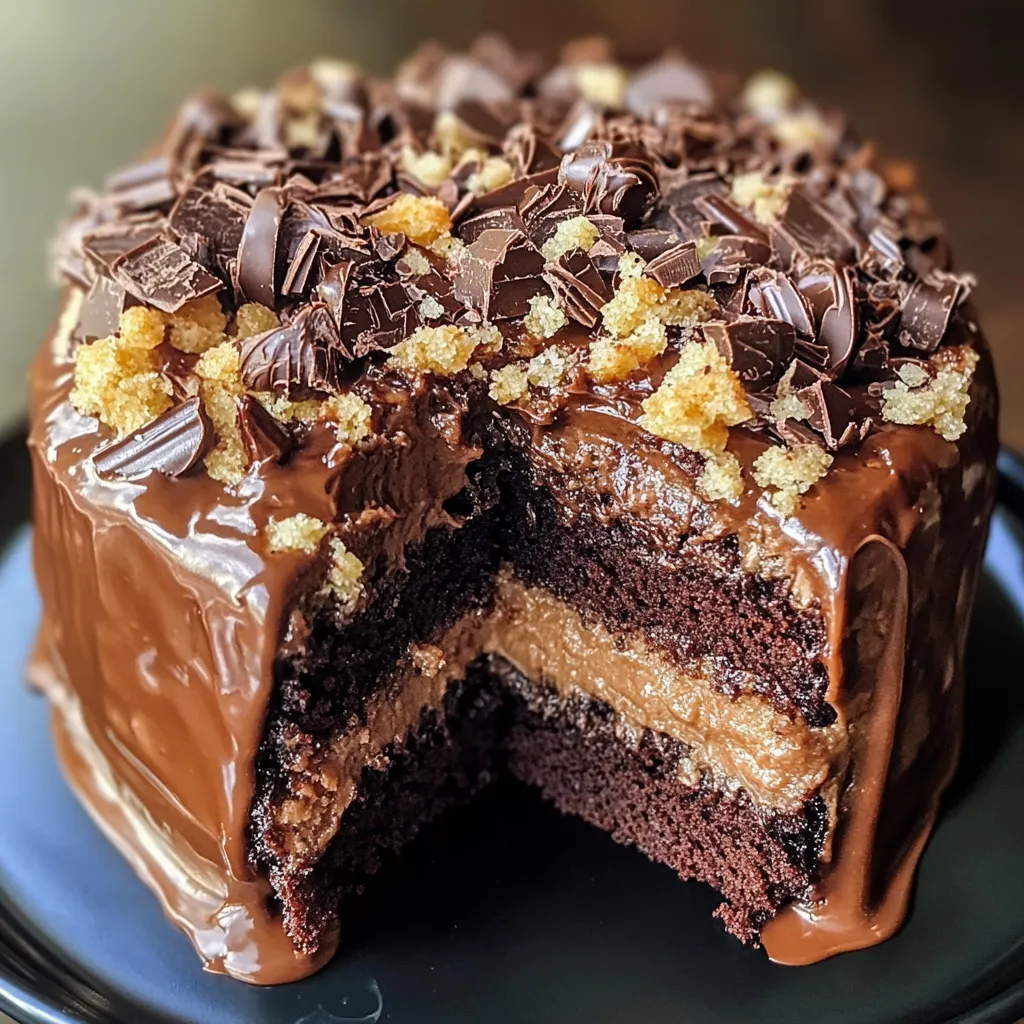
Pro Styling Tip: The naked sides showcasing the layers is signature to German chocolate cake. Don’t frost the sides!
Recipe Variations & Modern Twists
German Chocolate Poke Cake
This easier version has become incredibly popular:
- Bake cake in 9×13 pan
- Poke holes throughout warm cake
- Pour sweetened condensed milk over holes
- Top with coconut pecan mixture
- Serve directly from pan
German Chocolate Cake Cupcakes
- Makes 24 cupcakes
- Bake at 350°F for 18-20 minutes
- Core centers and fill with frosting
- Top with additional frosting
- Garnish with chocolate drizzle
German Chocolate Cake Cookies
Combine the flavors in cookie form:
- Chocolate cookie base
- Coconut pecan filling sandwiched between
- Or drop cookies with coconut mixed in
German Chocolate Bundt Cake
- Use bundt pan for elegant presentation
- Glaze with chocolate ganache
- Sprinkle coconut pecan mixture on top
German Chocolate Cheesecake
Layer cheesecake with German chocolate cake layers and coconut pecan topping for ultimate indulgence.
Dietary Adaptations
Gluten-Free German Chocolate Cake:
- Replace flour with 1:1 gluten-free baking blend
- Add 1/2 teaspoon xanthan gum if not in blend
- Increase eggs by one for structure
Vegan German Chocolate Cake:
- Use vegan chocolate
- Replace butter with vegan butter
- Use flax eggs (1 tbsp ground flax + 3 tbsp water per egg)
- Substitute coconut milk for evaporated milk
- Use aquafaba for whipped whites
Keto German Chocolate Cake:
- Almond flour instead of all-purpose
- Sugar-free sweetener
- Sugar-free chocolate
- Heavy cream instead of evaporated milk
Professional Tips for Perfect Results
Achieving the Perfect Texture
Room Temperature Ingredients: Everything except egg whites should be at room temperature. Cold ingredients won’t emulsify properly, creating a dense, uneven cake. Set out ingredients 2 hours before baking.
Don’t Overbake: German chocolate cake should be moist, almost fudgy. Better to underbake slightly than overbake. The cake continues cooking from residual heat after removal.
Proper Folding Technique: When folding in egg whites, use a large rubber spatula and cut down through center, scrape bottom, and fold over top. Rotate bowl 1/4 turn and repeat. Gentle folding preserves air bubbles.
Frosting Success Secrets
Constant Stirring: The German chocolate cake frosting requires patience. Constant stirring prevents scrambled eggs and ensures smooth, creamy texture. Use figure-8 motion covering entire pan bottom.
Right Consistency: Frosting should be thick enough to hold its shape but still spreadable. If too thick after cooling, add 1-2 tablespoons evaporated milk. If too thin, cook 2-3 minutes longer.
Make Ahead Option: Frosting can be made 3 days ahead and refrigerated. Bring to room temperature and stir before using.
Common Problems & Solutions
Dense, Heavy Cake:
- Overmixed batter (mix just until combined)
- Egg whites not whipped enough or deflated during folding
- Old baking soda (replace every 6 months)
Dry Cake:
- Overbaked (check 5 minutes early)
- Too much flour (spoon and level, don’t scoop)
- Oven temperature too high (use oven thermometer)
Frosting Won’t Thicken:
- Didn’t cook long enough (needs full 12 minutes)
- Heat too low (maintain medium heat)
- Needs more cooling time
Frosting Too Sweet:
- Add pinch of salt
- Toast coconut and pecans longer for deeper flavor
- Serve smaller slices with unsweetened whipped cream
Storage & Make-Ahead Instructions
Storing German Chocolate Cake
Room Temperature (Best for Flavor):
- Cover with cake dome or loosely with plastic wrap
- Keeps 2 days maximum
- Best served at room temperature
Refrigerator Storage:
- Wrap well or store in airtight container
- Keeps up to 5 days
- Remove 30 minutes before serving for best flavor
Freezing Instructions:
- Freeze unfrosted layers wrapped in plastic wrap and foil up to 3 months
- Freeze frosted cake uncovered until firm, then wrap well
- Thaw overnight in refrigerator
- Frosting may need stirring after thawing
Make-Ahead Timeline
3 Days Before:
- Make coconut pecan frosting
- Store covered in refrigerator
2 Days Before:
- Bake cake layers
- Cool completely
- Wrap tightly and store at room temperature
1 Day Before:
- Assemble cake
- Cover and refrigerate
Day Of:
- Bring to room temperature
- Add any garnishes
- Slice and serve
Frequently Asked Questions
Why is it called German chocolate cake if it’s not from Germany?
German chocolate cake is named after Sam German, an American who developed the sweet baking chocolate in 1852. The cake recipe itself was created in Texas in 1957, making it thoroughly American despite its misleading name.
What’s the difference between German chocolate cake and regular chocolate cake?
German chocolate cake uses sweet baking chocolate (milder and sweeter), includes buttermilk and whipped egg whites for lighter texture, and features coconut pecan frosting instead of chocolate frosting. Regular chocolate cake typically uses cocoa powder and has chocolate buttercream.
Can I use regular chocolate instead of German chocolate?
While German’s Sweet Chocolate is traditional, you can substitute with 3 oz semi-sweet chocolate plus 1 tablespoon sugar, or use 3 tablespoons cocoa powder plus 1 tablespoon butter plus 3 tablespoons sugar.
How do you make German chocolate cake frosting thicker?
Cook it longer (up to 15 minutes total), ensuring constant stirring. If already cooked, refrigerate to thicken. The frosting thickens considerably as it cools. If still too thin, you can add more coconut.
Can I make German chocolate cake without eggs?
Yes, though texture will differ. Use commercial egg replacer, or for each egg use: 1/4 cup applesauce, 1/4 cup mashed banana, or 1 tablespoon ground flax + 3 tablespoons water. The cake won’t be as light without whipped whites.
Why does my German chocolate cake frosting separate?
Separation occurs from cooking at too high heat or not stirring constantly. If it separates, remove from heat and whisk vigorously. If very curdled, blend with immersion blender or strain out lumps.
Can you freeze German chocolate cake?
Yes! Freeze layers separately or assembled. Wrap unfrosted layers in plastic wrap and foil for up to 3 months. For frosted cake, freeze uncovered until solid, then wrap well. Thaw overnight in refrigerator.
How long does German chocolate cake last?
At room temperature: 2 days covered. In refrigerator: 5 days in airtight container. In freezer: 3 months well wrapped. The cake actually improves in flavor after a day as flavors meld.
Serving Suggestions & Pairings
Classic Presentations:
- Traditional: Three layers with coconut pecan frosting on top and between layers, sides left bare
- Modern: Drizzle with chocolate ganache
- Elegant: Garnish with toasted coconut flakes and pecan halves
- Rustic: Dust with cocoa powder
Perfect Pairings:
- Coffee: Medium roast complements without overpowering
- Milk: Classic cold milk balances sweetness
- Wine: Port or cream sherry for special occasions
- Ice Cream: Vanilla or butter pecan
Portion Recommendations:
- Standard slice: 1/12 of cake (quite rich)
- Dessert party: 1/16 for smaller portions
- Children: 1/20 with milk
- Special occasion: Full slice with whipped cream
The Baker’s Final Secrets
After years of perfecting this German chocolate cake recipe, here are my non-negotiable rules for success:
- Never skip the egg white step – It’s what makes this cake special
- Use real butter – No substitutes in the frosting
- Toast your pecans – 5 minutes at 350°F transforms them
- Cool frosting completely – Patience creates perfect texture
- Measure accurately – Baking is science; precision matters
- Don’t frost the sides – Embrace the traditional naked look
- Make it ahead – This cake is actually better day two
Your Perfect German Chocolate Cake Awaits!
This homemade German chocolate cake recipe has been beloved since 1957 for good reason. The combination of light chocolate layers and rich coconut pecan frosting creates a dessert that’s worthy of any celebration. Whether you’re making it for a birthday, holiday, or just because you’re craving the best German chocolate cake recipe, this detailed guide ensures success.
From its fascinating history as an American creation to the modern variations like German chocolate poke cake, this dessert continues to evolve while maintaining its classic appeal. The key is quality ingredients, proper technique, and that signature coconut pecan frosting that makes German chocolate cake instantly recognizable.
Ready to create this classic? Let’s see your beautiful cakes!
📸 Share your creation with #GermanChocolatePerfection
⭐ Rate this recipe and help other bakers
💬 Leave a comment with your favorite variation
📌 Save this recipe for your next celebration
🖨️ Print the recipe card for easy reference
Recipe Summary Card
Prep Time: 1 hour
Cook Time: 35 minutes
Cooling Time: 3 hours
Total Time: 4 hours 35 minutes
Servings: 12-16 slices
Difficulty: Intermediate
Course: Dessert
Cuisine: American
Method: Baking
Keywords: german chocolate cake recipe, german chocolate cake, german chocolate cake frosting, coconut pecan frosting, homemade german chocolate cake, best german chocolate cake recipe, Baker’s german chocolate cake recipe, german chocolate cake icing, how to make german chocolate cake, original german chocolate cake recipe 1957
Nutritional Information (Per Slice, 1/12 of Cake)
- Calories: 680
- Total Fat: 38g
- Saturated Fat: 22g
- Cholesterol: 185mg
- Sodium: 320mg
- Carbohydrates: 78g
- Fiber: 3g
- Sugar: 58g
- Protein: 8g
Why is German chocolate cake called German?
It’s named after Sam German, who created “German’s Sweet Chocolate” in 1852. The cake recipe itself was first published in Texas in 1957, so it’s American, not German.
What makes German chocolate cake different from regular chocolate cake?
German chocolate cake uses melted sweet baking chocolate, buttermilk, and whipped egg whites for a lighter texture. It’s topped with a coconut pecan frosting instead of buttercream.
Can I make German chocolate cake without German’s Sweet Chocolate?
Yes. Substitute 3 oz semi-sweet chocolate plus 1 tablespoon sugar. The flavor won’t be identical but works well.
How do I thicken German chocolate cake frosting?
Cook it longer (up to 15 minutes) over medium heat while stirring constantly. The frosting thickens more as it cools.
How long does German chocolate cake last?
At room temperature, 2 days covered. In the fridge, up to 5 days in an airtight container. Freeze layers or frosted cake for up to 3 months.
Last updated: September 2025 | Originally published: January 2024
© ReadyInTen.com – This treasured recipe represents decades of baking tradition. Please share with attribution.

